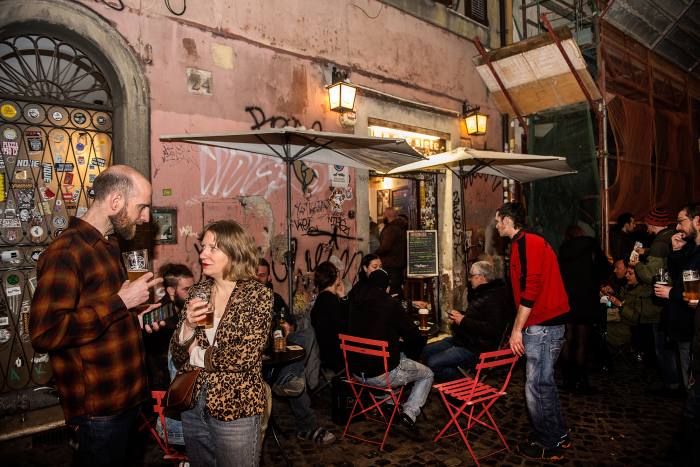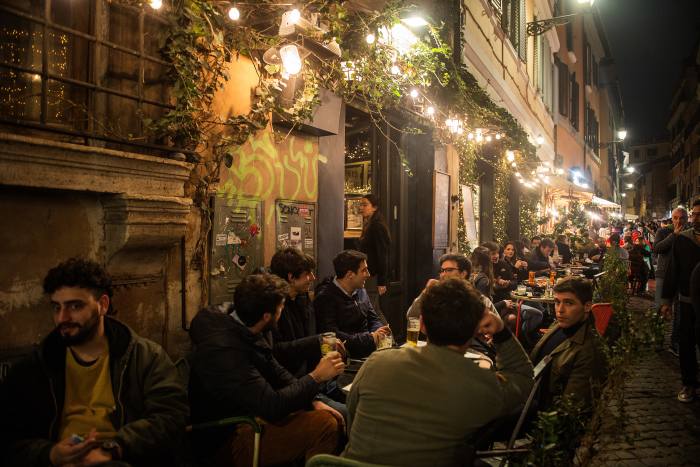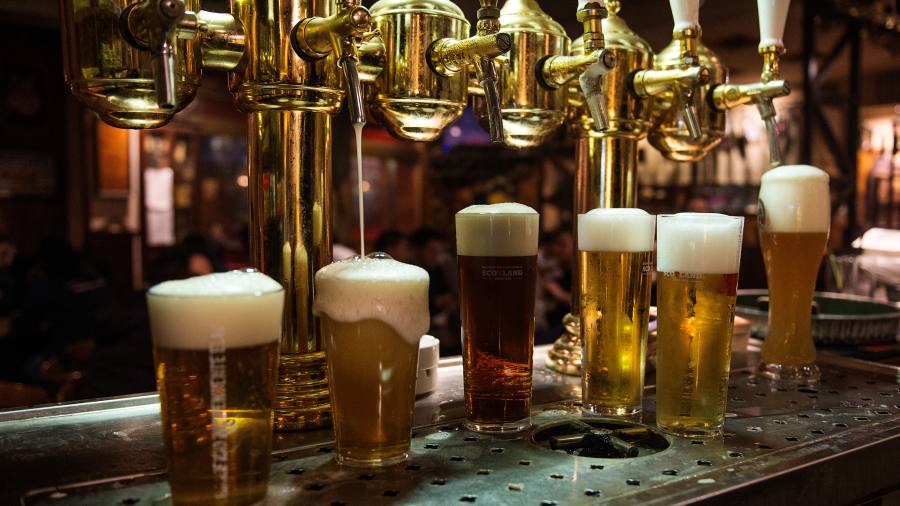
When the mausoleum containing Emperor Nero’s ashes was destroyed in the 12th century, it was rumoured his remains had been secretly deposited in a tomb on the historic Via Cassia road leading out of Rome to the north. The area supposedly became a place of pilgrimage for those keen to pay homage to the famously cruel, perpetually drunk emperor and, to this day, it is known colloquially as something it is almost certainly not: Tomba di Nerone.
It was here, on a wintry day in the 21st century, that I found myself on my own pilgrimage, not to pay my respects to the booze-doused fiddler but to visit a place stocked with the kind of high-powered beers that would have made even Nero hesitate: Tennent’s Pub. Its draft kegs contain Tennent’s Extra, with an eye-watering 9 per cent alcohol by volume (ABV), shipped all the way from Glasgow.
That a pub on Rome’s outskirts could be named after a brand so entwined with the fabric of Scotland, where its 4 per cent ABV lager reportedly accounts for two in every three pints poured, is not as unusual as it might first seem. Over the years, Italian drinkers have developed a thirst for one of the Scottish institution’s most infamous beers, the more powerful Tennent’s Super. Baffled Scots on holiday post pictures of these strange sightings on social media, expressing their surprise in colourful vernacular. “In Scotland, it’s for beetroot-faced street jaikies who have shat themselves but huvnae noticed, in Italy, it’s for sipping cold under the sun in a classy piazza with breadsticks and olives,” wrote Redditor Ferguson00. “Unreal how powerful advertising is.”
So popular is the Tennent’s brand that, in 2015, the brewery launched a promotional campaign called “the Italian job” in which it sought to hire two brand ambassadors who would travel Italy preaching the virtues of Vitamin T. The media branded it a dream job and, in the end, it turned out to be just that. After weeks of trying to track down these pint-pulling pulpiteers, my search came to an end when I discovered, via an email from the brewery, that it had never actually got around to hiring them. Disappointed by the non-existence of this evangelising pair, I decided to follow the path they might have taken.
My journey began on an unusually sunny day in February, when I visited Tennent’s Wellpark brewery, an east Glasgow institution founded in 1740. It is one of Scotland’s oldest running businesses and the proud originator of the first draft lagers in the UK (1924), the first canned lager (1935) and the first keg lager (1963). The whole site is overlooked by a huge storage vessel painted yellow in the style of a Tennent’s can. On my tour, I learnt of the beer’s deep-rooted Scottishness: Bonnie Prince Charlie drank the brewery’s earliest ales, so too did national poet Robert Burns. I also learnt that Tennent’s was one of the world’s biggest exporters of beer, a history tied inexorably to the British empire and its legacy. (A diver recently recovered a vintage Tennent’s from the shipwreck of a boat crashed in the 1870s by a drunken captain off the coast of Melbourne.)
In Scotland, the brand is so culturally ingrained that it’s simply the default lager. While it may not incite nationalistic fervour, or inspire the perfect-pour cult of fellow Celtic brew Guinness, the nectar is reliably just a Tennent’s. Outside Scotland, though, it’s unlikely that many British drinkers will have had so much as a sip. England and Wales aren’t commercial priorities compared with the domestic and export markets. And yet Tennent’s still ships its beers to 45 countries, with Italy one of its most crucial territories, according to the company.
One important but dull fact I learnt as I embarked on a labyrinthine quest to speak with parent group C&C is that Tennent’s doesn’t actually brew Tennent’s Super any more. When C&C bought Tennent’s from AB InBev in 2009 as part of a £180mn deal, it shed the beer from its portfolio for, as one newspaper put it at the time, its “Rab C Nesbitt image”, and AB InBev continues to brew it under licence in Luton.
My brewery tour included a group of Italians who milled around the gift shop afterwards, eagerly eyeing the Tennent’s golf balls. (My tour guide recalled having met more than one Italian sporting a Tennent’s tattoo.) I spent £80 on a jumper, hat and socks — my new uniform — and booked a flight to Italy.
It was Tennent’s Extra that I found myself drinking just off Via Cassia, near the tomb that may or may not house Nero’s remains. Seated in Tennent’s Pub, which has proudly fed and watered locals since 1996, I slowly sipped my pint as pub landlord Alessandro regaled me with tales of the Tennent’s Extra record-holder: a regular, the spitting image of Ivan Drago from Rocky IV, who put away 15 pints in a single evening. That’s the equivalent of 77 units of alcohol, 63 above the recommended weekly intake.
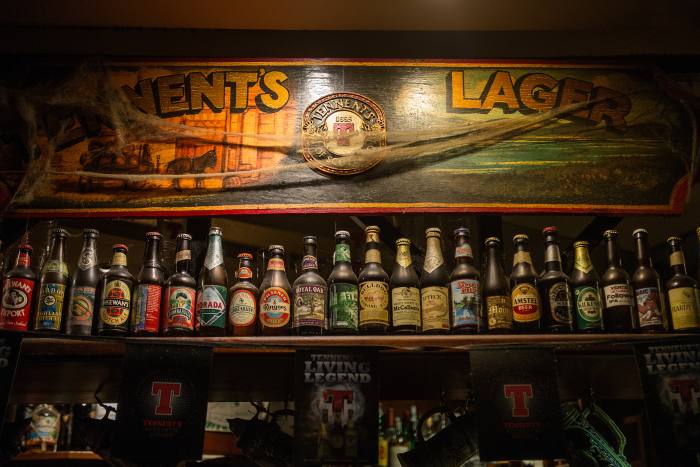
In Italy, these strong beers are called doppio malto or “double malt”. They are a sugary, high-alcohol beer, which after days of abuse in the name of journalism caused a bacchanalia to rage inside my head. Tennent’s Extra joins not only Tennent’s Super in Italy’s rogues’ gallery of doppio malto, but also Ceres Strong Ale — originally from Denmark, but mainly on sale in Italy — and Slalom, an allegedly Scottish beer that also seems to only exist in Italy. (“I never thought about where it was from. I assumed it was the depths of hell,” a Tennent’s Pub drinker named Lorenzo told me.) In Rome, the famously powerful beer brand Delirium Tremens, named for the hallucinatory shakes experienced after alcohol withdrawal, even has its own pub, decorated with pink elephants.
According to Piedmont-based food and drink writer Eugenio Signoroni, who helps compile the annual Birre d’Italia guide, the surprising success of Tennent’s Super can be explained by the fact that Italians simply favour stronger beers.
In Italy, beers have historically been lumped into one of four categories: birra chiara — clear beer, lighter fizzy lagers such as Peroni; birra rossa, or red beers — these are amber-coloured drinks that tend to be stronger and includes doppio malto; then there are birra bianca, the wheat beers; and finally, in a category of its own, there’s Guinness. In the national consciousness, a birra chiara is a weak beer and a birra rossa is strong. (A British session ale is, by this logic, an impossible drink to many Italians.) “All the doppio malto beers are considered stronger beers with more perfume, a more complex beer,” says Signoroni. “Tennent’s Super is the model of the doppio malto beer: it’s stronger. It’s full of character. It’s full of body, and it’s full of alcohol.”
When beers like Tennent’s Super and Ceres arrived in Italy over the previous decades, they disrupted a market that until then had largely been dominated by birra chiari like Peroni. These flaxen refreshments were for sipping in the summer or as a light accompaniment to a pizza. But beer remains Italy’s “second drink”, and it’s possibly because doppio malto beers are more like wine that they appealed to the market. “We are a wine nation, so drinking below 11 [per cent], below 12 [per cent] seems strange,” says Signoroni.
John Dickie, professor of Italian Studies at University College London and author of Delizia! The Epic History of the Italians and Their Food, adds that “something a little bit more like wine or an aperitivo might seem the natural option”. Until recently, he says, “many Italians were convinced that the doppio malto beers, like the mystifyingly popular Ceres, is what a good beer is.”
Doppio malto, then, are popular. From the mountainous Dolomites to the Tuscan hinterlands and Ortigia on the shank of Italy’s southernmost Sicilian boot, these bracing, syrupy tonics are available absolutely everywhere — on supermarket shelves, in cafés and pizzerias, on tap in pubs and bars. Signoroni tells me that I’ll have no trouble finding Ceres or Super in any of the city’s pizzerias, and he is correct. On my first night, I spotted doppio malto lining the shelves of traditional café-style bars, where one could in theory start the day by combining a creamy maritozzi with a Super, an espresso and then, presumably, a heart attack.
But an explosion of craft beer microbreweries, starting about two decades ago, has turned everything on its head. Rome-based food writer Katie Parla says that while Italy has always had something of a beer culture — “dating back to Etruscan times” — the emergence of microbreweries caused great waves and the country now enjoys a strong beer scene. Pioneer brewers such as Barley in Sardinia, Baladin from Cuneo, LoverBeer in Piedmont and Birra del Borgo in Lazio have used grassroots marketing efforts, like tap takeovers in big city pubs, and managed to chip away at the industrial producers to carve out a solid chunk of the market.
“We’ve got well over 1,000 craft brewers in Italy and there are even some in central Rome, like Jungle Juice,” says Parla, who positions Tennent’s Super today as the tipple of choice for football ultras, the most passionate and often most vocal fans. “The craft brewing scene in Rome is thriving, but you can go to virtually any village and find a local craft beer.”
The epicentre, she says, is a dive bar in bohemian Trastevere, a formerly working-class district west of the Tiber, called Ma Che Siete Venuti a Fà. “That’s where craft beer consumption in Rome started in earnest and then, by 2012, exploded,” Parla adds.
I was soon to meet publican and former death-metal vocalist Manuele Colonna, the owner of Ma Che Siete Venuti a Fà — named for a football chant, roughly translating as “What the hell did you come here for?” — who was fresh from yelling that very slogan, along with other unpublishable Italian words, in the basement of his craft beer pub during the screening of a Verona-Lazio match. Over a spicy ventricina and ‘nduja pizza at L’Elementare, a pizzeria and tap room, we exchanged small talk and I, slurring my words — having just finished a bottle of Super at nearby pub Baccanale Trastevere — suggested we reconvene when my head was clearer.
The next day, after a blasphemously hungover visit to the Sistine Chapel — I can confirm that the only bar in all of Vatican City does non vendi Tennent’s Super — I tramped up the same winding backstreets passing lively town squares, a basilica and other architecture of astonishing beauty to meet Colonna again. Sitting outside Ma Che in the bitter cold with friends, he greeted me with a raise of his comically oversized winter gloves, as he would every other passer-by. He poured me a delicious Seta wheat beer by Rurale and then a Griess Kellerbier from Franconia.
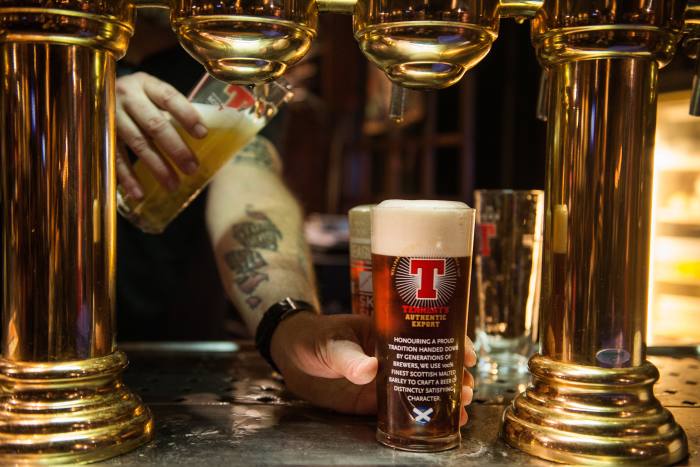
Colonna, who wears his hair tied taut in a ponytail and whose unpretentious appearance mirrors his attitude towards craft beer, told me that once upon a time Rome was a Tennent’s Super town. “When I was younger, Tennent’s Super and Slalom Strong were absolutely popular,” he said. “Tennent’s Super was a legendary beer in Italy.”
When he opened Ma Che in 2001, Tennent’s was the craft beer. “Twenty years ago, everybody drank beer, but nobody knew about it,” he said. “When people came to my bar, they’d say, ‘I don’t like beer.’ Then they’d try my beers and say, ‘This is wonderful, what is it?’ And I’d say, ‘It’s a fucking beer!’”
Since those days, Colonna has become a frequent visitor to the Franconia region of Germany, where he samples and retrieves intriguing lagers to stock in his pub. (Funnily enough, Hugh Tennent took a similar journey in 1885, when he travelled to Bavaria and introduced lager to the UK on his return.) After some initial resistance, double IPAs started to gain popularity among Italian drinkers in the 2010s, much like they did everywhere. But then came the craft beer “nerds”, who’d “break your balls” if you ordered a simple lager.
Colonna’s mission was to plough ahead, insisting that beer should be for “the people”, and today his bar is a busy community hub with a mix of patrons from all walks of life. The shift has been driven by the younger generation, he said: their changing tastes, an interest in the provenance of ingredients and a more health-conscious approach to drinking.
Along with the Franconian lagers that he’s so passionate about, some of which are still brewed using the same equipment from centuries ago, Colonna is equally excited by the current crop of Italian craft beers. Beers from breweries Ritual Lab and Alder are not only among the best in Italy, but in the world, he insisted. Yet with some exceptions, Italian breweries are poor at marketing themselves outside of domestic festivals like EurHop. “It’s a pity: our beers are among the best in Europe. It’s probably one of the best beer scenes for brewing knowledge and for the use of local ingredients,” he said. “But we are not able to promote ourselves”.
I wondered how Tennent’s could pitch itself to a country that was falling in love with craft beer. After a more rigorous vetting process than a G7 summit, Tennent’s finally granted me an interview once I’d a) confirmed that I understood Tennent’s had nothing whatsoever to do with Tennent’s Super any more, and b) remarked, unprompted, that I believed it to be the top commercial beer available in the UK. (Tennent’s Super brewer AB InBev did not respond to an interview request.)
“We always value speaking with Tennent’s enthusiasts,” Tennent’s brand manager Cameron Matthews told me. He was joined by his C&C colleague George Kyle. The affable pair, who share an encyclopedic knowledge of the brew, told me that premium beer is challenging standard lagers in Scotland, although Tennent’s has remained resilient. In Italy, tackling the craft market is something Tennent’s is currently working on, whether that’s with its lager, its gluten-free range — popular among those unfortunate coeliacs living in the land of pasta — or those in the Export Range like Tennent’s Extra. They said that Italy was the most important priority for Extra and that, in spite of the Ivan Drago type downing 15 pints of the stuff, they understood “the success of Export was on the basis of [Italy] not being a pint culture”, according to Kyle, “[more about] sharing, in group settings, and recognising the strength [of the beer]”.
Back in Cassia, taunted by retro Tennent’s wall hangings and other vintage adverts, I peered with hazy stupefaction at the final dregs of my accursed Extra, one of the few beers to give me a hangover before I’d finished drinking it. Of all the bottles, casks, ales and spirits to choose from, fellow pubgoer Lorenzo — who owner Alessandro says knocks back more beer than his car needs petrol — had opted for a Tennent’s Whisky Oak which, like Mithras slaying the bull, he dispatched with ease. “I just love red beers,” he told me, as the last of his brew shone a dusty gold.
To my mind, the appeal of these powerful beers, each as fearsome as a Neptunian storm, is hard to understand in a market with so many exciting alternatives. But here, at the rumoured site of a drunken emperor’s remains, the doppio malto seems destined to retain its legendary status.
Tamlin Magee is a writer based in the UK
Follow @FTMag on Twitter to find out about our latest stories first
